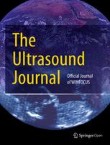Point-of-care ultrasound (POCUS) is rapidly becoming ubiquitous across healthcare specialties. This is due to several factors including its portability, immediacy of results to guide clinical decision-making, ...
Authors:
Minh-Phuong T. Le, Lara Voigt, Robert Nathanson, Anna M. Maw, Gordon Johnson, Ria Dancel, Benji Mathews, Alvaro Moreira, Harald Sauthoff, Christopher Gelabert, Linda M. Kurian, Jenna Dumovich, Kevin C. Proud, Jessica Solis-McCarthy, Carolina Candotti, Christopher Dayton…
Citation:
The Ultrasound Journal
2022
14:27
Content type: Original article
Published on: 7 July 2022
